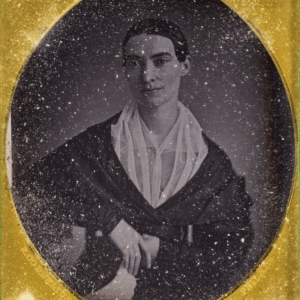JTF (just the facts): A total of 18 large scale color photographs, framed in white and unmatted, and hung against white walls in the main gallery space and near the reception desk. All of the works are archival pigment prints, made in 2024. Physical dimensions are 40×30, 24×30, or 14×11 inches, and all of the prints are available in editions of 5. The show also includes one larger poster. (Installation shots below.)
A photobook of this body of work has recently been published by Image Text Ithaca (here). Includes images by Lutz and three short stories by George Saunders. (Cover shot below.)
Comments/Context: Along with sunny sandy beaches, succulent oranges are a classic symbol for the state of Florida. Orange groves dot the entire peninsula, but are particularly densely packed in the southern half of the state, where frost is less likely to damage the fruit in the winter. So it’s not entirely surprising that US Route 441, a major roadway that runs from the Georgia border all the way down to Miami and further to the keys, cutting directly through tourist-centric Orlando on the way, has been nicknamed the scenic Orange Blossom Trail.
But family-friendly marketing and visible reality aren’t always entirely in alignment, and over the past few decades, stretches of the OBT have become plagued by urban/suburban decline, with strip malls and big box retailers giving way to even less savory businesses and seedier entertainments. And it is this consistent dissonance between image and real life, or between fantasy and truth, that stands at the center of Joshua Lutz’s recent project documenting the rhythms of existence along the OBT. This is a theme that Lutz has explored previously, as seen in his 2018 gallery show “Mind the Gap” (reviewed here), where deliberately uncomfortable images wrestled with photographic doubt in both personal and political ways. In “Orange Blossom Trail”, Lutz has followed a similar sense of societal unease, but created a much more powerfully integrated photographic statement.
A quick spin through the gallery reveals the most obvious thematic link between the images – every single picture includes at least a splash of orange or yellow-orange color, sometimes in the form of fruit, of course, but just as often in some other orange-hued everyday observation. Lutz first sets an idyllic OBT framework, with vintage appropriations of OBT marketing literature and orange crate illustrations (including a friendly native offering a stack of oranges to a Spanish conquistador), along with a coloring book image of a curious family visiting a fruit packing plant, the page expressively filled in with orange marker. And while Betty and Billy remark on how clean the factory is, that bright freshness and optimism quickly leak away when Lutz turns to more contemporary views of the OBT.
Many of the images on view in this edit of the project feature oranges as a subject, but really none of the fruit is seen with the sunny juiciness we might expect. Some oranges are seen hanging from trees, most a little post-peak, either dry, tough, and likely forgotten or a bit dirty and bruised, all failing to meet the standard of perfection seen in any grocery store. Hints of climate change and tougher days are found in netting that covers some trees (to prevent the attack of pests), while heavy cold raindrops wet another hanging pair of fruits set against a dull grey blur. Lutz then encourages the mood to deteriorate further in an image of a fallen grocery cart scattered with under ripe fruits and other cast offs, followed by another taken in the aftermath of a flood, where oranges dot the muddy ground. The general grimness reaches a low point in lushly seen images of rotting and decaying fruit, each orange now covered with weeping brown wounds and scavenging snails – we have clearly wandered pretty far off the optimistic path of the picture-postcard OBT.
When Lutz turns his attention to the surrounding built environment, his detail choices are similarly dispiriting: GUNS for sale, a U-Haul dealer, and a Now Hiring Get Paid Today sign near a bus stop. Perhaps to soften the blow of some of these cultural observations, several images have been veiled by frontal oranges allowed to fall into blur; the effect smartly mixes fantasy and reality in the same frame, with the sunny approximation of an orange not quite obscuring what’s going on behind. This approach is particularly successful in a neighborhood image featuring two landscapers with weed trimmers separated by the blurred fruit; the yard is perfectly manicured by these almost invisible workers, with the fruit providing another layer of obscuring misdirection.
When people do appear in Lutz’s photographs, they’re clearly not camera-toting tourists or wealthy vacationers down for a quick visit to Disneyworld. His images highlight the hard work of low paying, anonymous jobs along the OBT in construction, yard maintenance, window washing, mail delivery, and fruit processing, some featuring the bright orange and yellow vests that so neatly fit the artist’s overall color scheme. One elderly woman pushes a shopping cart full of bags wearing one of these vests, perhaps taking on a community role of grocery delivery, or maybe just wearing the vest to protectively stand out in the traffic. In general, Lutz’s photographs seem largely sympathetic to the plight of these workers, whose grinding get-the-job-done weariness inhabits most of the scenes.
Interleaving the symbolic with the literal, Lutz’s “Orange Blossom Trail” tells a story of 21st century American existence where the dreams have been dimmed quite a bit by the weight of everyday living. The project touches on suburbanization of the landscape, the alienation of workers and communities, and the growing pressures on cash-crop agriculture, blending them with a seductive Floridian mythology that doesn’t quite fit the contemporary picture and an understated (and perhaps unexpected) beauty as seen by Lutz’s eye. The result is an attentive and thought-provoking symphony of orange, where quiet resignation reigns over fading aspiration.
Collector’s POV: The prints in this show are priced at $4000, $3000, or $2000, based on size. Lutz’s work has little secondary market history at this point, so gallery retail likely remains the best option for those collectors interested in following up.



















